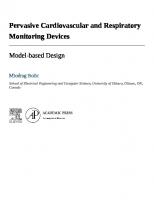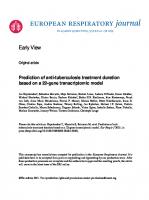European Respiratory Journal Prediction of anti-tuberculosis treatment duration based on a 22-gene transcriptomic model
203 9 3MB
English Pages [71] Year 2021
Recommend Papers
File loading please wait...
Citation preview
Early View Original article
Prediction of anti-tuberculosis treatment duration based on a 22-gene transcriptomic model Jan Heyckendorf, Sebastian Marwitz, Maja Reimann, Korkut Avsar, Andrew DiNardo, Gunar Günther, Michael Hoelscher, Elmira Ibraim, Barbara Kalsdorf, Stefan H.E. Kaufmann, Irina Kontsevaya, Frank van Leth, Anna Maria Mandalakas, Florian P. Maurer, Marius Müller, Dörte Nitschkowski, Ioana D. Olaru, Cristina Popa, Andrea Rachow, Thierry Rolling, Jan Rybniker, Helmut J.F. Salzer, Patricia Sanchez-Carballo, Maren Schuhmann, Dagmar Schaub, Victor Spinu, Isabelle Suárez, Elena Terhalle, Markus Unnewehr, January Weiner, Torsten Goldmann, Christoph Lange
Please cite this article as: Heyckendorf J, Marwitz S, Reimann M, et al. Prediction of antituberculosis treatment duration based on a 22-gene transcriptomic model. Eur Respir J 2021; in press (https://doi.org/10.1183/13993003.03492-2020).
This manuscript has recently been accepted for publication in the European Respiratory Journal. It is published here in its accepted form prior to copyediting and typesetting by our production team. After these production processes are complete and the authors have approved the resulting proofs, the article will move to the latest issue of the ERJ online.
©The authors 2021. For reproduction rights and permissions contact [email protected]
Original article submission ERJ-03492-2020-R1 European Respiratory Journal Prediction of anti-tuberculosis treatment duration based on a 22-gene transcriptomic model
Authors: Jan Heyckendorf1,2,3†*, Sebastian Marwitz4,5†, Maja Reimann1,2,3†, Korkut Avsar6, Andrew DiNardo7, Gunar Günther8,9, Michael Hoelscher10,11, Elmira Ibraim12, Barbara Kalsdorf1,2,3, Stefan H.E. Kaufmann13,14,15, Irina Kontsevaya1,2,3, Frank van Leth16,17, Anna Maria Mandalakas18, Florian P. Maurer19,20, Marius Müller21, Dörte Nitschkowski4,5, Ioana D. Olaru22,23, Cristina Popa12, Andrea Rachow10,11, Thierry Rolling24,25,26, Jan Rybniker27,28,29, Helmut J. F. Salzer30, Patricia Sanchez-Carballo1,2,3, Maren Schuhmann31, Dagmar Schaub1,2,3, Victor Spinu12, Isabelle Suárez27, Elena Terhalle1,2,3, Markus Unnewehr32,33, January Weiner 3rd 34
, Torsten Goldmann4,5†, Christoph Lange1,2,3,35†
Affiliations: 1
Division of Clinical Infectious Diseases, Research Center Borstel, Borstel, Germany
2
German Center for Infection Research (DZIF), Germany
3
International Health/Infectious Diseases, University of Lübeck, Lübeck, Germany
4
Pathology of the Universal Medical Center Schleswig-Holstein (UKSH) and the Research
Center Borstel, Campus Borstel, Airway Research Center North (ARCN) 5
German Center for Lung Research (DZL), Germany
6
Asklepios Fachkliniken München-Gauting, Munich, Germany
7
The Global Tuberculosis Program, Texas Children’s Hospital, Immigrant and Global Health,
Department of Pediatrics, Baylor College of Medicine, Houston, USA 8
Department of Medicine, University of Namibia School of Medicine, Windhoek, Namibia
9
Inselspital Bern, Department of Pulmonology, Bern, Switzerland
10
Division of Infectious Diseases and Tropical Medicine, University Hospital, LMU Munich,
Munich, Germany 11
German Center for Infection Research (DZIF), partner site Munich, Germany
12
Institutul de Pneumoftiziologie "Marius Nasta", MDR-TB Research Department, Bucharest,
Romania 13
Max Planck Institute for Infection Biology, Berlin, Germany
14
Max Planck Institute for Biophysical Chemistry, Göttingen, Germany
15
Hagler Institute for Advanced Study, Texas A&M University, College Station, USA
16
Department of Global Health, Amsterdam University Medical Centres, Location AMC,
Amsterdam, The Netherlands 17
Amsterdam Institute for Global Health and Development, Amsterdam, The Netherlands
18
The Global Tuberculosis Program, Texas Children’s Hospital, Immigrant and Global Health,
Department of Pediatrics, Baylor College of Medicine, Houston, USA 19
National and WHO Supranational Reference Laboratory for Mycobacteria, Research Center
Borstel, Borstel, Germany
20
Institute of Medical Microbiology, Virology and Hygiene, University Medical Center
Hamburg-Eppendorf, Hamburg, Germany 21
Sankt Katharinen-Krankenhaus, Frankfurt, Germany
22
London School of Hygiene and Tropical Medicine, London, United Kingdom
23
Biomedical Research and Training Institute, Harare, Zimbabwe
24
German Center for Infection Research (DZIF), Germany
25
Division of Infectious Diseases, I. Department of Internal Medicine, University Medical Centre
Hamburg-Eppendorf, Hamburg, Germany 26
Department of Clinical Immunology of Infectious Diseases, Bernhard-Nocht-Institute for
Tropical Medicine, Hamburg, Germany 27
Department I of Internal Medicine, Division of Infectious Diseases, University of Cologne,
Cologne, Germany 28
German Center for Infection Research (DZIF), Partner Site Bonn-Cologne, Cologne, Germany
29
Center for Molecular Medicine Cologne, University of Cologne, Cologne, Germany
30
Department of Pulmonology, Kepler University Hospital, Linz, Austria
31
Universitäts Thoraxklinik-Heidelberg, Heidelberg, Germany
32
Department of Respiratory Medicine and Infectious Diseases, St. Barbara-Klinik, Hamm,
Germany 33
University of Witten-Herdecke, Witten, Germany
34
Berlin Institute of HealthCUBI (Core Unit Bioinformatics), Berlin, Germany
35
†
Department of Medicine, Karolinska Institute, Stockholm, Sweden
Authors contributed equally
*Corresponding Author: PD Dr. med. Jan Heyckendorf, Medical Clinic, Research Center Borstel, Parkallee 35, 23845 Borstel, Germany; T +494537 188 2901; F +494537 188 6030: email: [email protected]
Take home message (230/256 characters): A 22-gene RNA-based model predicts individual durations of antimicrobial therapy for patients treated for tuberculosis. Application of this model will potentially shorten treatment duration in the majority of patients with MDR-TB.
Word count: 3445/3000
Keywords: biomarker, duration of therapy, MDR-TB, precision medicine, systems biology
Display items: 5 Figures, 2 Tables
Supplements: 4 Supplement Figures; 2 Supplement Tables; Supplement Methods and Results; List of genes of the different steps contributing to the therapy end model; TRIPOD checklist
Abstract (248/250): Background: The World Health Organization recommends standardized treatment durations for patients with tuberculosis. We identified and validated a host-RNA signature as a biomarker for individualized therapy durations for patients with drug-susceptible (DS)- and multidrug-resistant (MDR)-tuberculosis. Methods: Adult patients with pulmonary tuberculosis were prospectively enrolled into 5 independent cohorts in Germany and Romania. Clinical and microbiological data, and wholeblood for RNA transcriptomic analysis were collected at pre-defined timepoints throughout therapy. Treatment outcomes were ascertained Treatment outcomes were ascertained by TBNET criteria (6-month culture status/one-year follow-up). A whole-blood RNA therapy end model was developed in a multi-step process involving a machine-learning algorithm to identify hypothetical individual end-of-treatment timepoints. Results: Fifty patients with drug-susceptible (DS)-tuberculosis and 30 patients with MDRtuberculosis were recruited in the German identification cohorts (DS- and MDR-GIC), 28 patients with DS-tuberculosis and 32 patients with MDR-tuberculosis in the German validation cohorts (DS- and MDR-GVC), and 52 patients with MDR-tuberculosis in the Romanian validation cohort (MDR-RVC). A 22-gene RNA model that defined cureassociated end-of-therapy timepoints was derived from the DS- and MDR-GIC data. The model was superior to other published signatures to accurately predict clinical outcomes for patients in the DS-GVC (AUC=0.94 [95%CI:0.9-0.98]) and suggests that cure may be achieved with shorter treatment durations for tuberculosis patients in the MDR-GIC (mean reduction 218.0 days, 34.2%, p


![Pervasive Cardiovascular and Respiratory Monitoring Devices: Model-Based Design [1 ed.]
9780128209479, 012820947X](https://ebin.pub/img/200x200/pervasive-cardiovascular-and-respiratory-monitoring-devices-model-based-design-1nbsped-9780128209479-012820947x.jpg)







